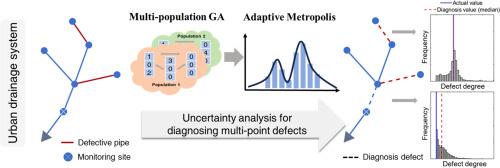Uncertainty analysis method for diagnosing multi-point defects in urban drainage systems
IF 11.4
1区 环境科学与生态学
Q1 ENGINEERING, ENVIRONMENTAL
引用次数: 0
Abstract
Urban drainage system (UDS) plays a key role in city urbanization, where defective pipes can lead to seepage. Previous studies have identified the locations of defects in UDS using inverse optimization models. However, the unique optimal solution neglects uncertainty analysis, which may lead to misdiagnosis. In addition, the multi-point defect diagnosis has heavy computational burden due to high dimensional parameters space. To address these issues, this paper proposes a hybrid method that leverages the genetic algorithm (GA) to identify probable space, and then utilizes the adaptive Metropolis (AM) to provide an estimation of the posterior probability distribution (PPD). Firstly, a multi-population GA is employed for the maximum exploration within the model space. Then, AM algorithm is used to explore the final PPD of each pipe defect parameter. The metrics accuracy (), Matthews correlation coefficient () and mean absolute error () are used to evaluate the diagnosis performance. A synthetic UDS case with randomized multi-point seepage scenarios is used to validate the method. Results indicate that the proposed hybrid method is effective in diagnosing multi-point defect, with 0.91, 0.78 of the hybrid method and 0.87, 0.69 of the DiffeRential Evolution Adaptive Metropolis method for the and , respectively. Meanwhile, the diagnosis speed has increased by 32 %. The result PPD passes the 90 % confidence interval validation. The proposed method can provide effective uncertainty analysis to reduce misdiagnosis of the traditional method.


诊断城市排水系统多点缺陷的不确定性分析方法
城市排水系统(UDS)在城市化进程中起着关键作用,管道缺陷会导致渗水。以往的研究利用反向优化模型确定了 UDS 的缺陷位置。然而,唯一最优解忽略了不确定性分析,可能导致误诊。此外,由于参数空间维度较高,多点缺陷诊断的计算负担较重。为解决这些问题,本文提出了一种混合方法,利用遗传算法(GA)识别可能空间,然后利用自适应 Metropolis(AM)提供后验概率分布(PPD)估计。首先,采用多群体 GA 在模型空间内进行最大限度的探索。然后,使用 AM 算法探索每个管道缺陷参数的最终 PPD。指标准确度(ACC)、马太相关系数(MCC)和平均绝对误差(MAE)用于评估诊断性能。采用随机多点渗流情景的合成 UDS 案例来验证该方法。结果表明,所提出的混合方法能有效诊断多点缺陷,混合方法的 ACC 和 MCC 分别为 0.91、0.78,而 DiffeRential Evolution Adaptive Metropolis 方法的 ACC 和 MCC 分别为 0.87、0.69。同时,诊断速度提高了 32%。结果 PPD 通过了 90% 置信区间验证。所提出的方法可以提供有效的不确定性分析,减少传统方法的误诊率。
本文章由计算机程序翻译,如有差异,请以英文原文为准。
求助全文
约1分钟内获得全文
求助全文
来源期刊

Water Research
环境科学-工程:环境
CiteScore
20.80
自引率
9.40%
发文量
1307
审稿时长
38 days
期刊介绍:
Water Research, along with its open access companion journal Water Research X, serves as a platform for publishing original research papers covering various aspects of the science and technology related to the anthropogenic water cycle, water quality, and its management worldwide. The audience targeted by the journal comprises biologists, chemical engineers, chemists, civil engineers, environmental engineers, limnologists, and microbiologists. The scope of the journal include:
•Treatment processes for water and wastewaters (municipal, agricultural, industrial, and on-site treatment), including resource recovery and residuals management;
•Urban hydrology including sewer systems, stormwater management, and green infrastructure;
•Drinking water treatment and distribution;
•Potable and non-potable water reuse;
•Sanitation, public health, and risk assessment;
•Anaerobic digestion, solid and hazardous waste management, including source characterization and the effects and control of leachates and gaseous emissions;
•Contaminants (chemical, microbial, anthropogenic particles such as nanoparticles or microplastics) and related water quality sensing, monitoring, fate, and assessment;
•Anthropogenic impacts on inland, tidal, coastal and urban waters, focusing on surface and ground waters, and point and non-point sources of pollution;
•Environmental restoration, linked to surface water, groundwater and groundwater remediation;
•Analysis of the interfaces between sediments and water, and between water and atmosphere, focusing specifically on anthropogenic impacts;
•Mathematical modelling, systems analysis, machine learning, and beneficial use of big data related to the anthropogenic water cycle;
•Socio-economic, policy, and regulations studies.
 求助内容:
求助内容: 应助结果提醒方式:
应助结果提醒方式:


